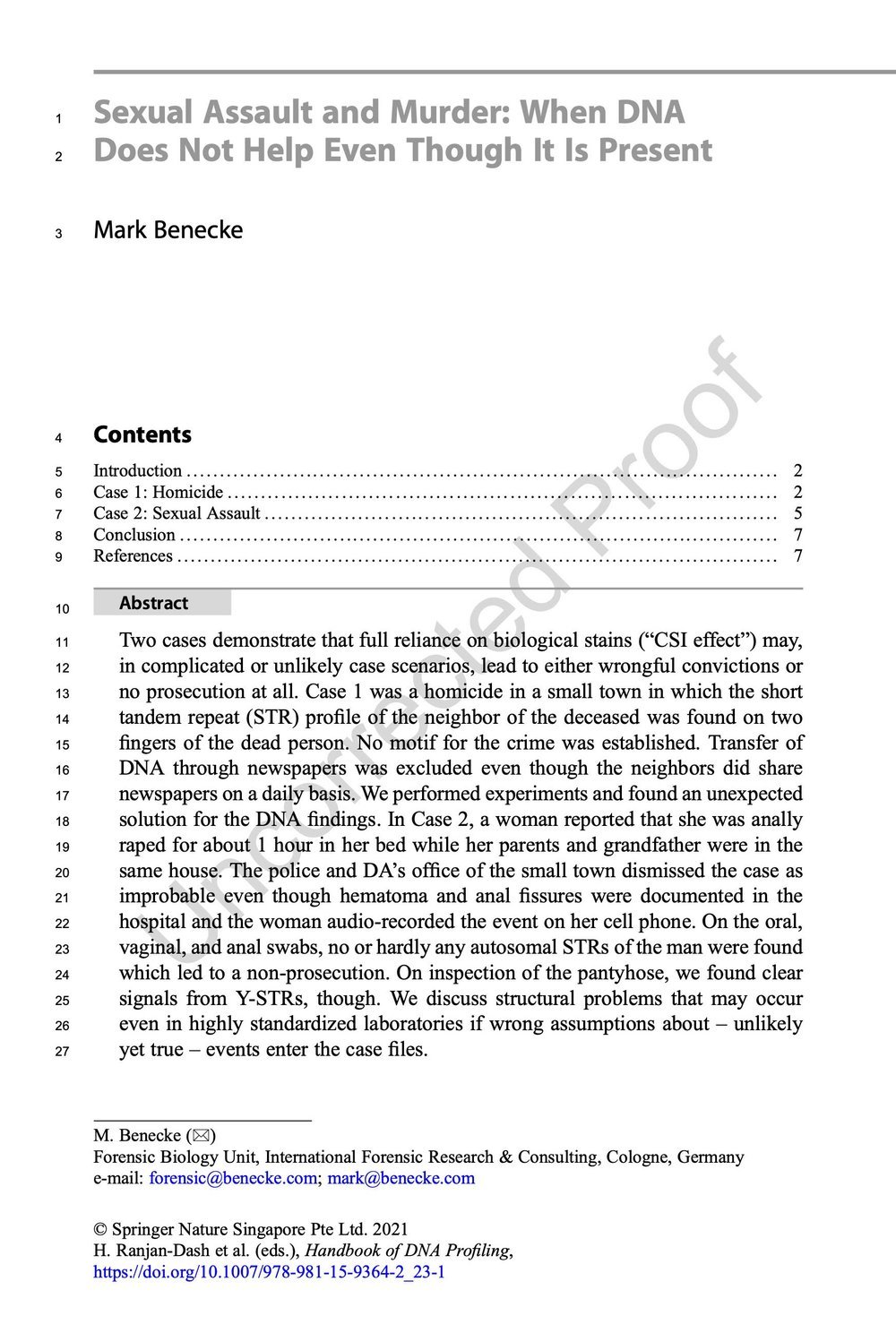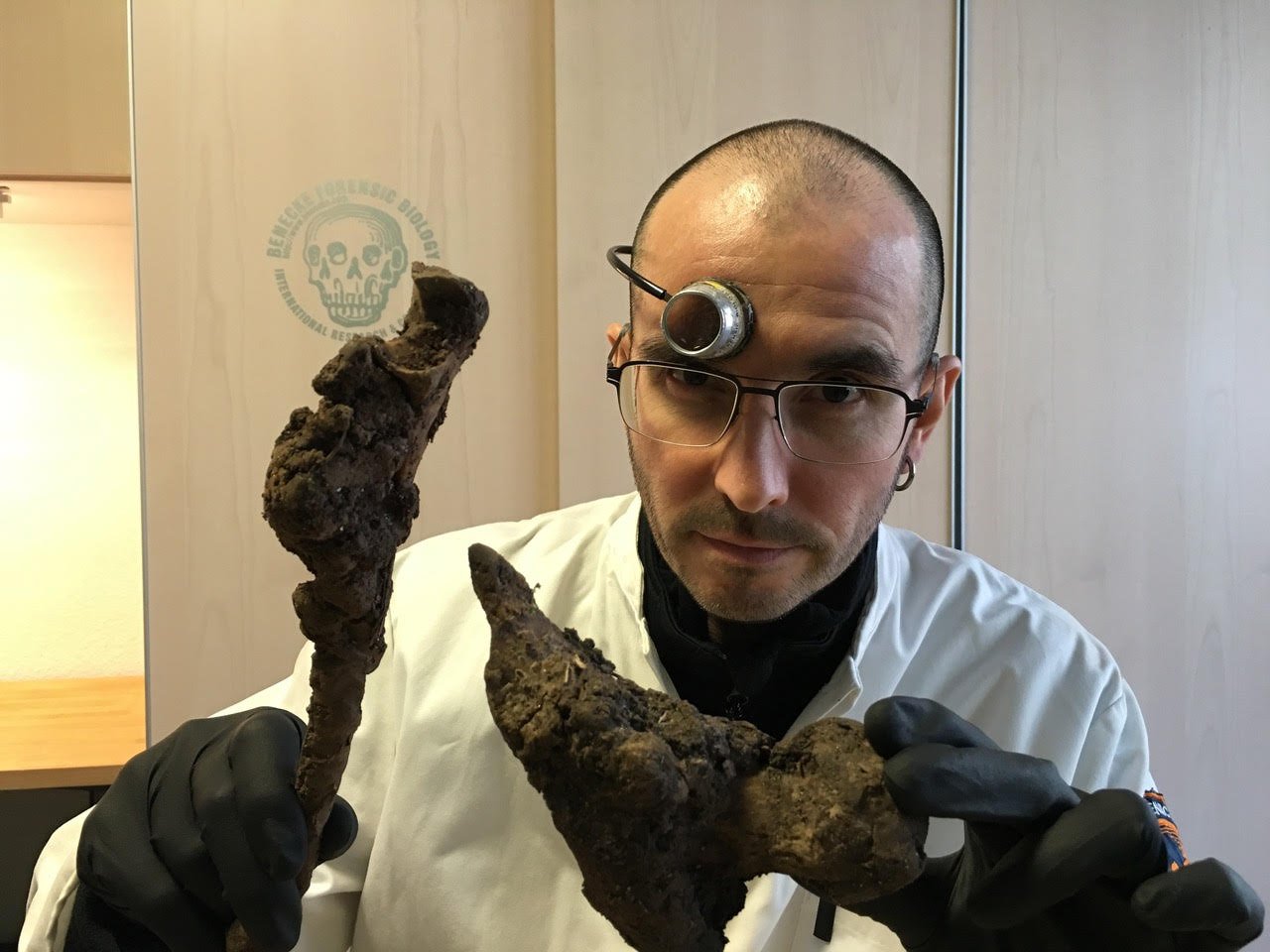DNA-based identification of a boiled, skeletonized, and varnished human skull, and of bone fragments found in a fireplace
Source: Am J Forensic Med Pathol (2001) 22(4): :412–4, doi: 10.1097/00000433-200112000-00016.
The article as .pdf
Sivolap Y, Krivda G, Kozhuhova N, Chebotar S, Benecke M
In an apartment, bone fragments were found in a fireplace. Furthermore, a varnished skull was found elsewhere in the same apartment. The tenant confessed to a murder and stated that the head of a victim, a girl, was boiled for 12 hours. He stated that the soft tissue was then removed and the skull was varnished. Other parts of the body were burned to ashes in an open field. Comparison of loci D19S252, CD4, CYAR04, TII01, F13A01, F13B, and D6S366 from the skull and the bone remains to loci of the mother of a missing girl showed that the skull came from that missing child. Biological maternity was calculated as 99.99%. The bone pieces were DNA typed as male and did not share alleles with the mother in several systems. Therefore, they belonged to a different (human) victim.
Key Words: STR DNA typing, Genetic fingerprint, Ashes, Homicide, Hypervariable DNA
Hypervariable regions consisting of tandem repeated nucleotide sequences allow the individualization or the determination of the origin of biologic material (1–3). The alleles show somatic stability, and they are inherited according to classic mendelian genetics (4). In contrast to long minisatellite DNA stretches (up to sizes of 20 kb), short tandem repeats as a standard tool for forensic biologic investigations, consisting of short stretches of tandem repeats with a basic motiv (DNA core sequence) length of 2–7 bp (average size range: 80–400 bp), and with a high level of allelic polymorphism (average 8–12 alleles) (3,5–7), were used for the following investigation that was performed for the Bureau of Medico-Legal Investigations in Odessa, Ukraine.
CASE REPORT
In an apartment, a varnished skull of a child, and bone fragments in a fireplace, were found (Fig. 1). The tenant and two other persons confessed to the murder of a girl in November 1997 that had taken place in the woods near a settlement of the Aeronaval area of Simferopol. The suspects said they had cut off the head of their victim, boiled it for approximately 12 hours, removed the soft tissue, covered the skull with varnish, and burned the rest of the body. We performed a maternity test on the skull and on the bone fragments, based on a comparison of the genotypes with those of the suspected victims. The father could not be located.
DNA Isolation: Liquid Blood
Chelex extraction (8) was performed, and 5 yl of supernatant was used for polymerase chain reaction. Fragments of skull temple bones and bones found in the fireplace were subjected to these procedures: spongiosa (inner bone material) was powdered by a metal file and incubated for 3 hours in 1 ml of double-distilled water, and then centrifuged in an Eppendorf tube. The supernatant was used for Chelex extraction. All extracts were stored at 4°C. For amplification, 20 l reaction mix conditions as given in (9–12)) on a Tercik thermocycler (DNA Technology, Russia). The DNA oligonucleotide primers for PCR were synthesized in our own laboratories on a DNA sequencer (Applied Biosystems 310). For electrophoresis and analysis, 5 l of PCR product each, electrophoresis in 10% polyacrylamide (PAG; length 16 cm, thickness 0.75 mm, Hoefer Scientific gel chamber); silver staining of the PAG was performed according to (13). Digitalized gels were analyzed with Kodak Digital Science EDAS 120 software.
Results of Analysis
Comparison of the loci D19S252, HUMCD4, HUMCYAR04, HUMTH01, HUMF13A01, HUMF13B, and D6S366 showed that the DNA of the mother shared fragments with the DNA of the skull (Table 1). Maternity was calculated according to (14) with P = pa(2-pa) for the case that the genotype of the child was homozygous, or P = pa(2-pa)+pb(2-pb)-2pa pb for a heterozygous profile. P values were as follows: D19S252, 0.126; HUMCD4, 0.108; HUMCYAR04, 0.136; HUMTH01, 0.423; HUMF13A01, 0.045; HUMF13B, 0.474; and D6S366, 0.812. The cumulative probability of a random match of genotypes (Pcum) was calculated as the product of probabilities of single loci: Pcum = 0.0000134. The probability for biologic maternity (n) was calculated with n = (1 - Pcum) x 100% = (1 - 0.0000134) x 100% = 99.99%. The bone fragments in the fireplace did not match the mother’s DNA profile. The amplification results from the sex-specific locus amelogenin showed that the skull bones belonged to a female and that the bones found in the fireplace belonged to a male. IT was concluded that with a probability of 99.99%, the skull removed from the apartment originated from the suspected victim, a girl, and that the bones found in the fireplace and the skull belonged to different individuals. These results show that body parts that have been actively heated during a prolonged period can be DNA typed as well as the remains of mass disaster victims (15–17).
REFERENCES
1. Jeffreys AJ, Wilson V, Thein SL. Hypervariable “minisatellite” regions in human DNA. Nature 1985;314:67–73.
2. Jeffreys AJ, Wilson V, Thein SL, Weatherall DJ, Ponder BAJ. DNA “fingerprints” and segregation analysis of multiple markers in human pedigrees. Am J Hum Genet 1986;39:11–24.
3. Benecke M. DNA typing in forensic medicine and in criminal investigations: a current survey. Naturwissenschaften 1998;84: 181–8.
4. Wells R. Genome dactylography. In: Davies K, ed. Genome analysis [Russian]. Moscow: Mir, 1990:191–213.
5. Edwards A, Civitello A, Hammond HA, Caskey CT. DNA typing and genetic mapping with trimeric and tetrameric tandem repeats. Am J Hum Genet 1991;49:746–56.
6. Edwards A, Hammond HA, Lin L, Chakraborty R. Genetic variation of five trimeric tandem repeat loci in four human population groups. Genomics 1992;12:241–3.
7. Polymeropoulos MH, Xiao H, Rath DS, Merril CR. Tetranucleotide repeat polymorphism at the human aromotase cytochrome P450 gene (CYP19). Nucleic Acids Res 1991;19:195.
8. Walsh P, Metsger D, Higuchi R. Chelex 100 as a medium for simple extraction of DNA for PCR-based typing from forensic material. Biotechniques 1991;10:506–13.
9. Chistiakov DA, Chelnokova MV, Efremov IA, Stupakova MV, Odinokova OI, Nosikov VV. Distribution of alleles of microsatellite loci HUMCYAR04 and D19S253 in population samples of two Russian cities. [Russian]. Genetika 1997;33:262–8.
10. Efremov I, Zaiats M, Ivanov P. An expert evaluation of molecular genetic individualizing systems based on the HUMvWFII and D6S366 tetranucleotide tandem repeats [Russian]. Sud Med Ekspert 1998;42:33–6.
11. Sullivan KM, Mannucci A, Kimpton CP, Gill P. A rapid and quantitative DNA sex test: fluorescence-based PCR analysis of X-Y homologous gene amelogenin. Biotechniques 1993;15: 636–8;640–1.
12. Turakulov RI, Chistiakov DA, Odinokova ON, Nosikov VV. Allelic polymorphism of short tandemly repeating sequences of the HUMF13A01 and HUMCD4 loci in Russian populations from Moscow and Tomsk [Russian]. Genetika 1997;33: 979–85.
13. Lomholt B, Frederiksen S. Detection of a few picograms of DNA on polyacrylamide gels by silver staining. Anal Biochem 1987;164:146–9.
14. Perepechina I, Grishechkin S. Probability in DNA typing: methodical recommendations [Russian]. Moscow: EKC MIA of Russia, 1996:1–16.
15. Clayton TM, Whitaker JP, Maguire CN. Identification of bodies from the scene of a mass disaster using DNA amplification of short tandem repeat (STR) loci. Forensic Sci Int 1995;76: 7–15.
16. Clayton TM, Whitaker JP, Fisher DL, et al. Further validation of a quadruplex STR DNA typing system: a collaborative effort to identify victims of a mass disaster. Forensic Sci Int 1995;76:17–25.
17. Frégeau CJ, Leclair B, Bowen K, Elliott J, Borys S, Fourney R (2000) The Swissair Flight 111 disaster. Short tandem repeat mutations observed. In: Sensabaugh GF, Lincoln PJ, Olaisen B, eds. Progress in forensic genetics 8. Amsterdam: Elsevier: 2000;40–2.















